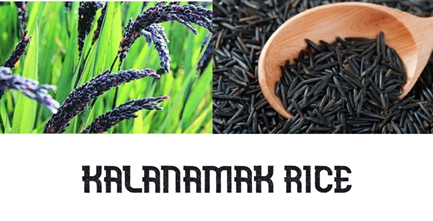Kalanamak rice
Context:
The Indian Agriculture Research Institute (IARI) has successfully developed two dwarf varieties of Kalanamak rice.

What is Kalanamak rice?
- Kalanamak is a traditional variety of paddy with black husk and strong fragrance.
- It has high salt content and overshadows basmati due to its agronomic potential.
- It is grown in 11 districts of the Terai region of northeastern Uttar Pradesh and in Nepal.
- The traditional variety of the rice has been prone to ‘lodging’ which resulted in low yield and poor quality.
- Lodging is a condition in which the top of the plant becomes heavy because of grain formation, the stem becomes weak, and the plant falls on the ground.
- To overcome the problem of lodging, the Indian Agriculture Research Institute (IARI) has successfully developed two dwarf varieties of Kalanamak rice.
- It is currently grown in 11 districts of the Terai region of northeastern Uttar Pradesh and in Nepal (specifically Kapilvastu).
- This rare rice has been awarded the Geographical Indication (GI) tag in 2013 which recognised Siddharthnagar and the adjacent districts for the tag.
- Under the One District One Product (ODOP) Scheme, it has earned the Prime Minister's award for Excellence in Public Administration 2021.
- It was featured in the book 'Speciality Rices of the World' by the Food and Agriculture Organization (FAO) of the United Nations.
|
The variety is considered a gift from Lord Buddha to the people of Sravasti when he visited the region after enlightenment. |
New varieties:
- Two dwarf varieties of Kalanamak rice are named;
- Pusa Narendra Kalanamak 1638
- Pusa Narendra Kalanamak 1652
- The yield of the new varieties is double that of the traditional variety. The length of the old variety plant is 140 centimetre, and the new variety is between 95- 100 centimetre.
- The breeding programme was done by bringing the dwarfing genes from the rice variety Bindli Mutant 68, and also the gene of Pusa Basmati 1176 was used as a parent to cross with Kalanamak, and the progenies were further back-crossed with Kalanamak to restore its quality.
Benefits of Kalanamak Rice:
- Highly resistant to notorious rice diseases like panicle blast, stem rot and brown spot that cause huge crop losses for the farmers, unlike the Dehradun basmati which is highly susceptible to diseases.
- Bacterial blight is rarely observed in this rice variety.
- Requires low water content and doesn’t need standing water during transplantation.
- Can be grown without chemical fertilisers and pesticides.
- Low input and labour cost.
- It was observed that the 2001-2003 droughts in the Terai region left the Kalanamak rice yield unaffected.
About Indian Agricultural Research Institute (IARI):
|

